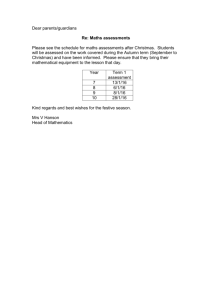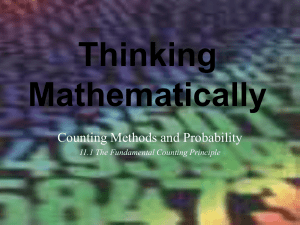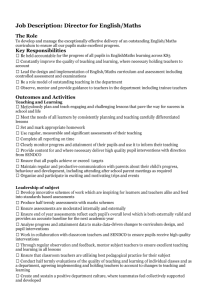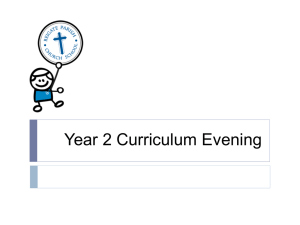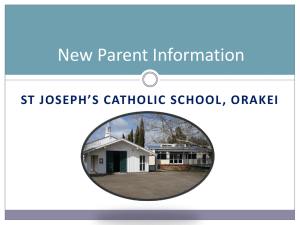Assessment
advertisement
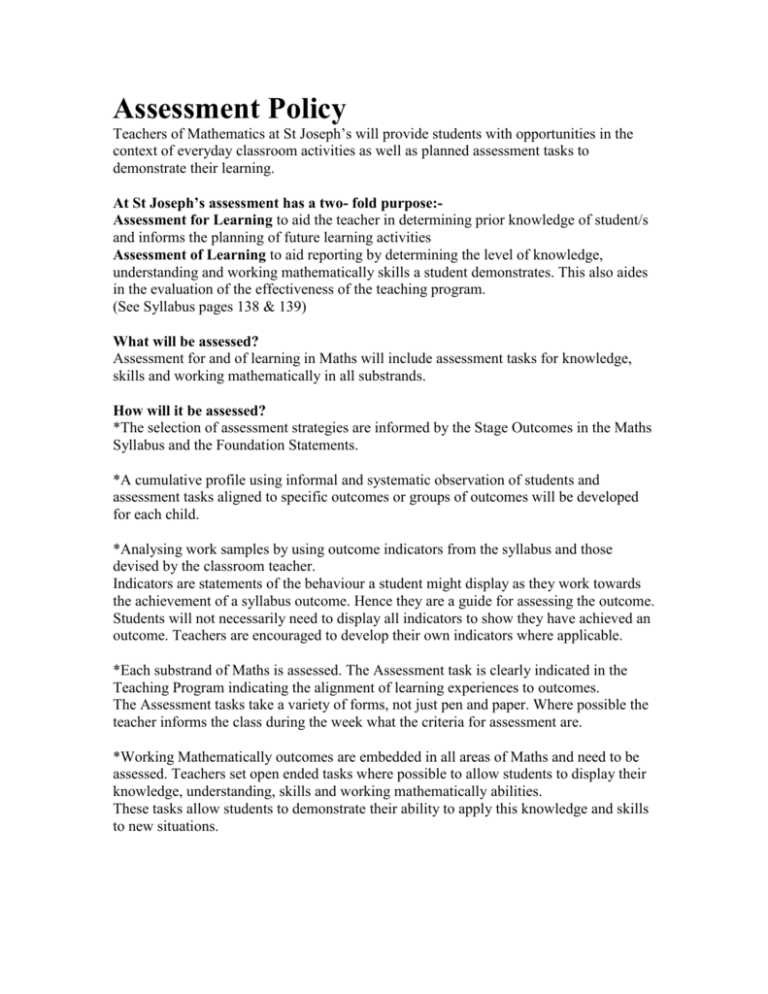
Assessment Policy Teachers of Mathematics at St Joseph’s will provide students with opportunities in the context of everyday classroom activities as well as planned assessment tasks to demonstrate their learning. At St Joseph’s assessment has a two- fold purpose:Assessment for Learning to aid the teacher in determining prior knowledge of student/s and informs the planning of future learning activities Assessment of Learning to aid reporting by determining the level of knowledge, understanding and working mathematically skills a student demonstrates. This also aides in the evaluation of the effectiveness of the teaching program. (See Syllabus pages 138 & 139) What will be assessed? Assessment for and of learning in Maths will include assessment tasks for knowledge, skills and working mathematically in all substrands. How will it be assessed? *The selection of assessment strategies are informed by the Stage Outcomes in the Maths Syllabus and the Foundation Statements. *A cumulative profile using informal and systematic observation of students and assessment tasks aligned to specific outcomes or groups of outcomes will be developed for each child. *Analysing work samples by using outcome indicators from the syllabus and those devised by the classroom teacher. Indicators are statements of the behaviour a student might display as they work towards the achievement of a syllabus outcome. Hence they are a guide for assessing the outcome. Students will not necessarily need to display all indicators to show they have achieved an outcome. Teachers are encouraged to develop their own indicators where applicable. *Each substrand of Maths is assessed. The Assessment task is clearly indicated in the Teaching Program indicating the alignment of learning experiences to outcomes. The Assessment tasks take a variety of forms, not just pen and paper. Where possible the teacher informs the class during the week what the criteria for assessment are. *Working Mathematically outcomes are embedded in all areas of Maths and need to be assessed. Teachers set open ended tasks where possible to allow students to display their knowledge, understanding, skills and working mathematically abilities. These tasks allow students to demonstrate their ability to apply this knowledge and skills to new situations. Assessment at St Joseph’s includes a variety of the following activities:*Basic Skills Tests *SENA 1 &2 and Counting On testing *Observation *Checklists and Anecdotal notes *Work Samples *Testing of prior knowledge/understanding/working mathematically skills *Self evaluation and reflection including learning journals *Peer assessment *Explanations and demonstrations to others *Questions posed by students *Practical tasks such as measurement *Student’s oral and written recordings and reports *Short quizzes and Pen and paper tests *Comprehension and interpretation exercises *Teacher/student discussions and interviews *Student’s plans for and solutions to the solving of problems *Photographing students work When will it be assessed? TERM TERM 1 YEAR Kinder Yr 3 Yr 5 All Grades TERM 2 All Grades TERM 3 All Grades Yr 3 and Yr5 TERM 4 ALL STUDENTS ASSESSMENT TYPE SENA 1 initial test SENA 2 to all Yr 3 students Counting On assessment to all Year 5 Variety of assessment tasks designated in Teaching Program, Portfolio Tasks Continual update of SENA 1 and 2 and Counting On through ongoing, in class assessment to be current prior for Mid Year Reports. Variety of assessment tasks designated in Teaching Program, Portfolio Tasks Continual update of SENA 1 and 2 and Counting On through ongoing, in class assessment. Variety of assessment tasks designated in Teaching Program, Portfolio Tasks Basic Skills Test Intensive review of SENA 1 and 2 and Counting On to update student assessment. Variety of assessment tasks designated in Teaching Program, Portfolio Tasks Updating of Tracking Sheets NOTE: If a student is ready to move on to the SENA 2 or Counting On Assessments before these designated times the class teacher administers the assessment early. Tracking Sheets Commencing in 2006 all students will have their progress recorded on a SENA 1and 2 Tracking Sheet. Initial assessments are updated regularly as part of general classroom ongoing assessment. These updates are shown on the individual student tracking sheets which are passed on to the new class teacher the following year. Count Me In Too/ Counting On All teachers at St Joseph’s, K-6 have been trained in the CMIT Learning Framework and the associated assessment for learning- SENA 1 & 2 and Counting On Assessments. These Assessments form part of both our Assessment FOR and OF Learning. Teachers group their Maths Classes for Number based on where these assessments place students on the Learning Framework. Activities are chosen from the Developing Efficient Numeracy Strategies (DENS) Books 1 & 2 and Counting On Folder to cater for the different levels of ability of the groups. *Assessment Criteria- What makes an ABCD or E? In Maths the depth of understanding and knowledge, the ability to work mathematically, and demonstrate and apply this knowledge, processes and skills is what determines a grade assigned. Teachers need to set tasks that are open needed enough to allow for the demonstration of higher levels of working mathematically, greater knowledge and understanding. Assigning a “Grade” ABCD or E. Reporting expectations- to assign a grade to a particular Foundation Statement the teacher is informed by a variety of work samples and observations in all the relevant strands. *Portfolios Two work samples from each strand, including the outcome and written comment, are assessed in detail and included in the student’s portfolio- one sample for Semester 1 and one sample for Semester 2. Student portfolios are sent home with students at the end of Term 2 & 4. These are followed by a Parent/Teacher Interview where portfolios and other work samples are discussed. These work samples are selected from assessment tasks. Parents are made aware that the stated outcome is where students are expected to be at the end of the Stage, (not at the end of Semester 1 Year 5 for example), but that the ABCDE is assigned according to where they are expected to be at this point in time taking into account what has been taught.
